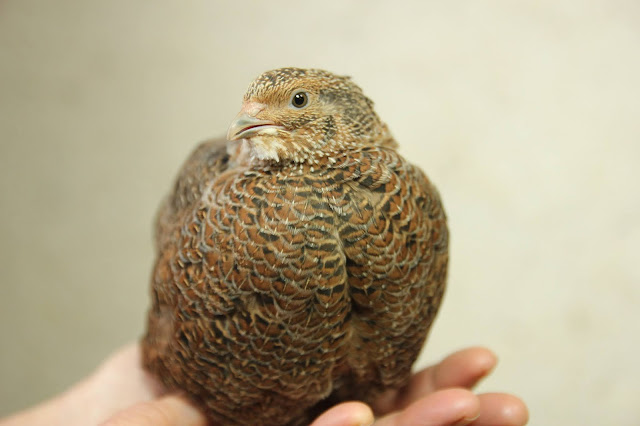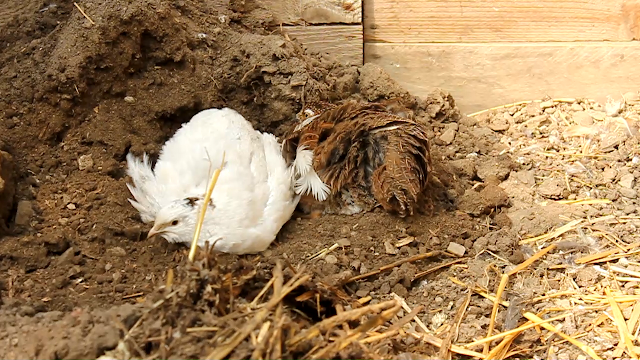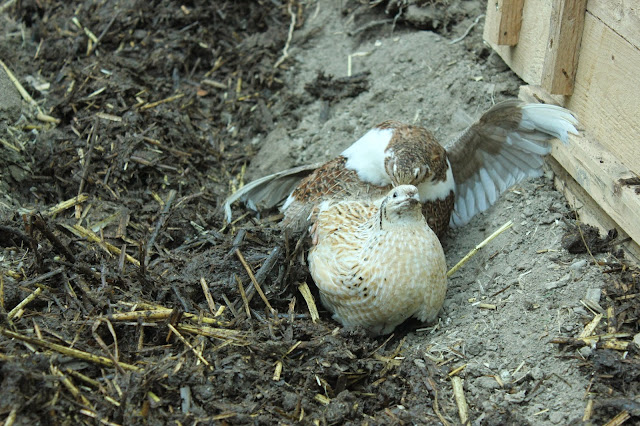I'm not sure why this would be, possibly hidden within the genetics of breeding these lovable creatures but along with the golden quail, discussed here in Part 2, the English White, Pandas, Tibetan and Rosetta Tuxedo, seem to be the most friendly of all the quail I have bred. Together with this characteristic, in fact instrumental in its process, is the ability of these quail to bond to each other in monogamous pairs and thus to revert to their natural instincts to nest and hatch. Thus, if your ambition is to breed quail for companionship, gardening and free-ranging ability and the penchant for raising their own chicks then in my opinion, mixing these colours into your flock is the way to achieve your goals.
It has been interesting when researching the colours of coturnix to come up against such a paucity of information. Creating a Tibetan or Rosetta quail, with their beautiful and complex feathering is surely something to crow about but the origins at present seem lost, or maybe they will be found at some time. It certainly took me some digging in my recent Cochin article to find the name of the owner of the mourning Pekinese, who were unceremoniously snatched from their mistresses' dead body and carried off as trophies to furnish the first breeds of these dogs in the West.
 Trying to find the history of the English White quail or in fact any of the above is a rather tortuous process and getting more so unfortunately, as for most of my origins of specific poultry breeds, I have to dig into older texts and articles. For, what presents itself on the internet tends to involve a greater proportion of cut-and-paste and a mix of confusion. For example the name English White is often used as synonymous with the Texas A&M quail. The latter is actually very easy to trace, the clue is in the name and was a large or 'Jumbo' hybrid a cross with the 'Texas Gourmet' a quail first raised by the Texas A&M's Poultry Department in 1995 by Dr. Fred Thornberry and trialed at the Diamond H Ranch. When
Trying to find the history of the English White quail or in fact any of the above is a rather tortuous process and getting more so unfortunately, as for most of my origins of specific poultry breeds, I have to dig into older texts and articles. For, what presents itself on the internet tends to involve a greater proportion of cut-and-paste and a mix of confusion. For example the name English White is often used as synonymous with the Texas A&M quail. The latter is actually very easy to trace, the clue is in the name and was a large or 'Jumbo' hybrid a cross with the 'Texas Gourmet' a quail first raised by the Texas A&M's Poultry Department in 1995 by Dr. Fred Thornberry and trialed at the Diamond H Ranch. When
Dr Lee Cartwright joined the Faculty he began a program of breeding the Gourmet quail with the English White this too was/is mainly for commercial use but many 'backyard' breeders do raise them and I have also found organically raised Texas A&M in the UK.
Left top: English White female and Rosetta Tuxedo male.
Below left: English White chick
There is a sort of subset of the English White called 'Panda' where the head shows patches of 'Pharaoh' or wild quail feathering. These actually are very pretty and the markings can be in interesting shapes, I have had several with heart shapes. Sometimes the patches of colour turn up on the back and wings too. It is actually quite hard to breed a totally white quail and some breeders report that over-breeding of whites has the potential to produce albino quail. In the juveniles at the drinking fountain (left) you can see the Panda patterning beginning to appear within the distribution of the emerging feathers.
My simple understanding of the genetics for how the different combinations of colours for feather show up and in what proportions is, that with the pied birds, known as Tuxedos, the genes for recessive white make the 'waistcoat, 'shirtfront' and sometimes also 'sleeves'. The dominant chocolate or chestnut colour from the Tibetan or Rosetta will then make the 'tail coat' and 'trousers'. These are the two sorts of Tuxedo I have had to date but I believe you can make Tuxedos out of any combination(s) of dominant colours with recessive white.
Dark British Range aka Tibetan is a beautiful bird, in which like the white the female is larger than the male. In French this colour in quail and pheasants is called 'Obscure' which is a more poetic way of saying dark.
A close up of the plumage shows some incredible patterning and the birds themselves I have always found to be friendly albeit the females can become very dominant.
Similarly with the Rosetta, there are some amazing nuances of shades and markings when you look at the feathers in detail. At this magnification you can see the subtle influence of Pharaoh patterning but there is a lot more to it than that.
Sir John Sebright, although ultimately taking his secret to his grave viz., the genetics of the beautiful bird that bears his name, freely admitted that he would produce any given feather in three years.
Thus it would seem fitting that the person who created these should make themselves known!
The Rosetta (above) aka British Range, is a beautiful bird which was created from a combination of English White and Dark British Range.
Left is a Golden Italian mother with her Rosetta Tuxedo chick
With the Rosetta, the females are larger than the males and in the ones I have, the females are more friendly, although they can get very assertive and vocal around other younger males, in the nesting season. In particular they use a very unusual sort of 'yammering' or guttural chattering, which is a vocalisation I haven't heard from other quail in relation to territory and hierarchy disputes with juveniles.
The males of both the Rosetta Tuxedo above and the Tibetan Tuxedo below are not unfriendly but just seem to be more wary of humans than the female Tuxedos.
Now here's the film of our beautiful English White and Pandas:
Looking at my quail in their Winter sleeping quarters, I can't help thinking of an exotic box of chocolates, whatever the name and whoever came up with these spectacular feather colours, they are truly beautiful.
It has been interesting when researching the colours of coturnix to come up against such a paucity of information. Creating a Tibetan or Rosetta quail, with their beautiful and complex feathering is surely something to crow about but the origins at present seem lost, or maybe they will be found at some time. It certainly took me some digging in my recent Cochin article to find the name of the owner of the mourning Pekinese, who were unceremoniously snatched from their mistresses' dead body and carried off as trophies to furnish the first breeds of these dogs in the West.
 Trying to find the history of the English White quail or in fact any of the above is a rather tortuous process and getting more so unfortunately, as for most of my origins of specific poultry breeds, I have to dig into older texts and articles. For, what presents itself on the internet tends to involve a greater proportion of cut-and-paste and a mix of confusion. For example the name English White is often used as synonymous with the Texas A&M quail. The latter is actually very easy to trace, the clue is in the name and was a large or 'Jumbo' hybrid a cross with the 'Texas Gourmet' a quail first raised by the Texas A&M's Poultry Department in 1995 by Dr. Fred Thornberry and trialed at the Diamond H Ranch. When
Trying to find the history of the English White quail or in fact any of the above is a rather tortuous process and getting more so unfortunately, as for most of my origins of specific poultry breeds, I have to dig into older texts and articles. For, what presents itself on the internet tends to involve a greater proportion of cut-and-paste and a mix of confusion. For example the name English White is often used as synonymous with the Texas A&M quail. The latter is actually very easy to trace, the clue is in the name and was a large or 'Jumbo' hybrid a cross with the 'Texas Gourmet' a quail first raised by the Texas A&M's Poultry Department in 1995 by Dr. Fred Thornberry and trialed at the Diamond H Ranch. When Dr Lee Cartwright joined the Faculty he began a program of breeding the Gourmet quail with the English White this too was/is mainly for commercial use but many 'backyard' breeders do raise them and I have also found organically raised Texas A&M in the UK.
Left top: English White female and Rosetta Tuxedo male.
Below left: English White chick
There is a sort of subset of the English White called 'Panda' where the head shows patches of 'Pharaoh' or wild quail feathering. These actually are very pretty and the markings can be in interesting shapes, I have had several with heart shapes. Sometimes the patches of colour turn up on the back and wings too. It is actually quite hard to breed a totally white quail and some breeders report that over-breeding of whites has the potential to produce albino quail. In the juveniles at the drinking fountain (left) you can see the Panda patterning beginning to appear within the distribution of the emerging feathers.
 |
| English White 'Panda' and Tibetan Tuxedo enjoy a similarly 'pied' lettuce |
 |
| Rosetta Tuxedo dining alone |
Dark British Range aka Tibetan is a beautiful bird, in which like the white the female is larger than the male. In French this colour in quail and pheasants is called 'Obscure' which is a more poetic way of saying dark.
A close up of the plumage shows some incredible patterning and the birds themselves I have always found to be friendly albeit the females can become very dominant.
Similarly with the Rosetta, there are some amazing nuances of shades and markings when you look at the feathers in detail. At this magnification you can see the subtle influence of Pharaoh patterning but there is a lot more to it than that.
Sir John Sebright, although ultimately taking his secret to his grave viz., the genetics of the beautiful bird that bears his name, freely admitted that he would produce any given feather in three years.
Thus it would seem fitting that the person who created these should make themselves known!
The Rosetta (above) aka British Range, is a beautiful bird which was created from a combination of English White and Dark British Range.
Left is a Golden Italian mother with her Rosetta Tuxedo chick
With the Rosetta, the females are larger than the males and in the ones I have, the females are more friendly, although they can get very assertive and vocal around other younger males, in the nesting season. In particular they use a very unusual sort of 'yammering' or guttural chattering, which is a vocalisation I haven't heard from other quail in relation to territory and hierarchy disputes with juveniles.
The males of both the Rosetta Tuxedo above and the Tibetan Tuxedo below are not unfriendly but just seem to be more wary of humans than the female Tuxedos.
Now here's the film of our beautiful English White and Pandas:
Looking at my quail in their Winter sleeping quarters, I can't help thinking of an exotic box of chocolates, whatever the name and whoever came up with these spectacular feather colours, they are truly beautiful.
Thanks for dropping by and do feel free to share experiences or ask for further information in the comment section. If you have enjoyed this piece and found it useful think about sharing it with your family and friends, on social media and also maybe about joining this blog and/or subscribing to my Youtube channel or even supporting us on Patreon or
Until next time, all the very best from Normandie! Sue
RELATED ARTICLES
The Colours of Coturnix Quail - Intro & Brown
In the pages of this site, I write mostly on practical issues and as
'The Holistic Hen', I do always hope that I am looking at the whole
bird. Thus plumage colour is important ....read more
The Colours of Coturnix Quail 2 - Gold
The controversial Golden quail is there just one or more and what's with
the yellow lethal allele? That and more discussed here....read more
Encouraging Pair-bonding, Nesting and Broodiness in Coturnix Quail
I'm sharing the setting up of a safe quail breeding area. Andy and I
created this last year but the broody quail beat us to it...read more
In Search of the Singing Coturnix
Two World Wars destroyed the bloodline of the singing quail, which had been established over centuries. Now however...read more
RETURN TO CONTENTS PAGE
© 2020 Sue Cross
© 2020 Sue Cross




























